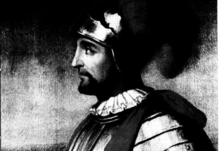Juan de Salcedo
Juan de Salcedo (Spanish pronunciation: [ˈxwan de salˈθeðo]; 1549 – March 11, 1576) was a Spanish conquistador. He was born in Mexico in 1549 and he was the grandson of Miguel López de Legazpi and brother of Felipe de Salcedo. Salcedo was one of the soldiers who accompanied the Spanish colonization of the Philippines in 1565. He joined the Spanish military in 1564 for their exploration of the East Indies and the Pacific, at the age of 15. In 1567, Salcedo led an army of about 300 Spanish and Mexican soldiers and 600 Visayan (Filipino) allies along with Martín de Goiti for their conquest of Islamic Manila (then under occupation by the Sultanate of Brunei). There they fought a number of battles against the Muslim leaders, mainly against Tarik Sulayman (ironically named from the Arabic طارق بن زياد Tāriq, Islamic conqueror of Spain before the Christian Spanish expelled the Muslims during the Reconquista). The Spanish officers, Mexican recruits and Filipino warriors coalesced in 1570 and 1571 to attack the Islamised areas of Luzon, for control of lands and settlements.
Juan de Salcedo | |
|---|---|
 Juan de Salcedo, 16th century Spanish conquistador in the Philippines | |
| Born | 1549 Mexico City, New Spain |
| Died | March 11, 1576 (aged 26–27) |
| Nationality | Spanish |
| Known for | Conquistador plus Explorer and erstwhile lover of Dayang-dayang (Princess) Kandarapa. |
William Scott called Salcedo, "the last of the Conquistadores." In May 1572, Salcedo led an exploration expedition of 45 Spaniards northward. Leaving 30 of his men at Vigan, Salcedo proceeded to sail around the northern coast, and down the eastern shore, with 15 men in 2 open boats. He returned to Manila 3 months later with 50 pounds of gold.[1]
In 1574, Salcedo hurried back to Manila, when that city was threatened by Limahong and he fought with his 600 warriors (300 Mexicans and Spaniards plus 300 local Filipino Militia) against 6,500 Chinese pirates and Japanese Ronins. After the Spanish success in the Battle of Manila (1574), Salcedo pursued Limahong to Pangasinan in 1575. There the Spaniards besieged the pirates for four months, before Limahong made good his escape.[2][3][1]
Salcedo died in March 1576, probably of dysentery, at the age of 27.[1]
His body is interred at the San Agustin Church in Intramuros.
Romance with Princess Kandarapa
Local folk legends and a written account by Don Felipe Cepeda, Salcedo's aide,[4] who returned to Acapulco, recount that after the Spanish conquest of Luzon and their consequent takeover of the Pasig River delta polity of Tondo, which was the previous preeminent state in Luzon before the Brunei Sultanate established their puppet-kingdom, Islamic Manila, to supplant Tondo, Juan de Salcedo, then about 22 years old, fell in love with the 18-year-old Dayang-dayang ("Princess") Kandarapa, said to be the niece of Lakandula, Tondo's Lakan ("Paramount ruler").[5] Their love was completely against their forebears wishes since Lakan Dula wanted his niece, Dayang-dayang Kandarapa, to be married to the Rajah of Macabebe and Miguel Lopez de Legaspi wanted his Mexican grandson, Salcedo, to marry a pure Spanish woman. However, at one time so the legend goes, Kandarapa sent Salcedo a message within a cluster of white Lotus flowers (The Lotus flower is the most sacred flower in Tantric Mysticism since it is pure and beautiful despite growing from the mud of its surroundings). However, princess Kandarapa mistakenly thought that Salcedo had been unfaithful to her and so, she died of a broken heart. Upon going back from his campaigns, Salcedo learned of her death and yet kept her token of fidelity with him until the end. It is said that when he died in Ilocos, he had in his breast pocket, the dried leaves of the Lotus flowers Kandarapa gave him. This romance, as recorded by Don Felipe Cepeda in Mexico, was picked up by the Catalonian Jesuit, Rev. Fr. Jose Ibañez, who published this romance in Spain.[6]
See also
References
- Scott, William (1974). The Discovery of the Igorots. Quezon City: New Day Publishers. pp. 9–10, 48–49. ISBN 9711000873.
- Kenji, Igawa (2010). Antony, Robert (ed.). at the Crossroads: Limahon and Wako in Sixteenth-Century Philippines, in Elusive Pirates, Persavie Smugglers. Hong Kong: Hong Kong University Press. pp. 78–82. ISBN 9789888028115.
- Sande, Francisco de (2004). Blair, E.H.; Robertson, J.A. (eds.). Relation of the Filipinas Islands: Manila, June 7, 1576. In The Philippine Islands 1493-1898, Vol. 4 of 55 1576-1582. Project Gutenberg EBook. Retrieved 19 January 2019.
- Don Felipe Cepeda by Nick Joaquin
- Ordoñez, Minyong (2012-08-19). "Love and power among the 'conquistadors'". Philippine Daily Inquirer. Retrieved 2017-09-28.
- Besa, Emmanuel. "Tales of Intramuros". Retrieved 19 January 2019.
- Morga, Antonio de. (2004). The Project Gutenberg Edition Book : History of the Philippine Islands – 1521 to the beginning of the XVII century. Volume 1 and 2.
- Legazpi, Don Miguel López de. (1563–1572). Cartas al Rey Don Felipe II : sobre la expedicion, conquistas y progresos de las islas Felipinas. Sevilla, España.